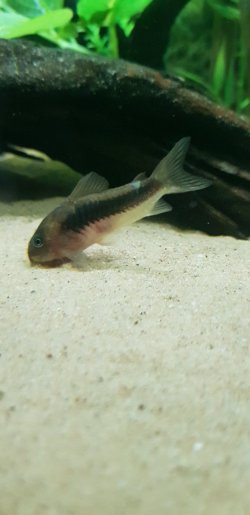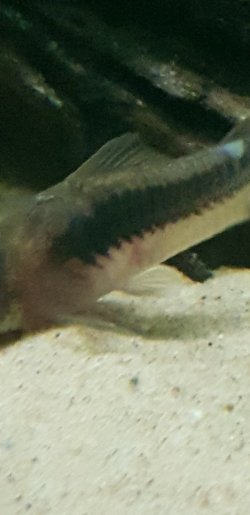Still got this mysterious illness in my oldest Bronze Cory, Im guessing some sort of bacterial infection?
It gets a white spot on tail fin, then it clears up after a few days,Then after a week it appears next to the dorsal fin but larger & he has blood streaks in the abdomen area.
It affects only the 1 cory who is 5 yrs old, Hes active as the others & eats well but now & again he twists & flicks around
This has been happening for a few months now on & off. Not sure what to do next??
It's an external protozoan infection (Costia, Chilodonella or Trichodina). You can treat it with salt.
The protozoan parasites are in most tanks and affect all fish to some degree. Older fish or sick fish are more prone to developing infections because of their weaker immune system.
The protozoan parasites bite the fish's skin and this irritates the fish causing it to rub on objects or flick about. The fish produces excess mucous over the damaged area to help protect the site. This is why there is a creamy white patch on the fish, it is excess mucous over the irritated area.
When the parasites build up in number and start doing lots of damage, the skin can bleed and you get red patches on the fish.
Red patches can also be caused by bacteria, poor water quality, and a dirty tank/ filter.
--------------------
Wipe the inside of the glass down with a clean fish sponge.
Do a 75% water change and gravel clean the substrate every day for a week. The water changes and gravel cleaning will reduce the number of disease organisms in the water and provide a cleaner environment for the fish to recover in.
Make sure any new water is free of chlorine/ chloramine before it is added to the tank.
Clean the filter if it hasn't been done in the last 2 weeks. However, if the filter is less than 6 weeks old, do not clean it. Wash the filter materials/ media in a bucket of tank water and re-use them. Tip the bucket of dirty water on the garden/ lawn. Cleaning the filter means less gunk and cleaner water with fewer pathogens.
Increase surface turbulence/ aeration when using salt or medications because they reduce the dissolved oxygen in the water.
Add some salt, (see directions below).
--------------------
SALT
You can add rock salt (often sold as aquarium salt), sea salt or swimming pool salt to the aquarium at the dose rate of 1 heaped tablespoon per 20 litres of water. If there is no improvement after 48 hours you can double that dose rate so there is 2 heaped tablespoons of salt per 20 litres.
Keep the salt level like this for at least 2 weeks but no longer than 4 weeks otherwise kidney damage can occur. Kidney damage is more likely to occur in fish from soft water (tetras, Corydoras, angelfish, Bettas & gouramis, loaches) that are exposed to high levels of salt for an extended period of time, and is not an issue with livebearers, rainbowfish or other salt tolerant species.
The salt will not affect the beneficial filter bacteria, fish, plants, shrimp or snails.
After you use salt and the fish have recovered, you do a 10% water change each day for a week using only fresh water that has been dechlorinated. Then do a 20% water change each day for a week. Then you can do bigger water changes after that. This dilutes the salt out of the tank slowly so it doesn't harm the fish.
When you do water changes while using salt, you need to treat the new water with salt before adding it to the tank. This will keep the salt level stable in the tank and minimise stress on the fish.





